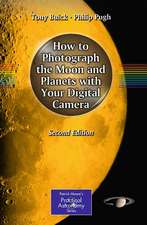Observational Molecular Astronomy: Exploring the Universe Using Molecular Line Emissions: Cambridge Observing Handbooks for Research Astronomers, cartea 10
Autor David A. Williams, Serena Vitien Limba Engleză Hardback – 24 noi 2013
Preț: 289.04 lei
Nou
Puncte Express: 434
Preț estimativ în valută:
55.31€ • 57.90$ • 45.76£
55.31€ • 57.90$ • 45.76£
Carte disponibilă
Livrare economică 17-31 martie
Livrare express 28 februarie-06 martie pentru 33.53 lei
Preluare comenzi: 021 569.72.76
Specificații
ISBN-13: 9781107018167
ISBN-10: 1107018161
Pagini: 184
Ilustrații: 41 b/w illus. 24 tables
Dimensiuni: 155 x 235 x 14 mm
Greutate: 0.48 kg
Ediția:New.
Editura: Cambridge University Press
Colecția Cambridge University Press
Seria Cambridge Observing Handbooks for Research Astronomers
Locul publicării:New York, United States
ISBN-10: 1107018161
Pagini: 184
Ilustrații: 41 b/w illus. 24 tables
Dimensiuni: 155 x 235 x 14 mm
Greutate: 0.48 kg
Ediția:New.
Editura: Cambridge University Press
Colecția Cambridge University Press
Seria Cambridge Observing Handbooks for Research Astronomers
Locul publicării:New York, United States
Cuprins
Introduction; 1. Spectra and excitation of molecules; 2. Astrochemical processes; 3. Physical processes in different astronomical environments; 4. Molecular tracers in the Milky Way galaxy; 5. Molecular tracers in external galaxies; 6. The Early Universe and the first galaxies; 7. Recipes for molecular submillimetre astronomy; 8. Chemical and radiative transfer models; 9. Observations: which molecule, which transition?
Recenzii
'This book is an excellent introduction to the field of molecular line astrophysics. Williams and Viti cover the range of astrophysical conditions that can be probed, and the most useful molecules and transitions. The expositions are lucid, and each chapter directs the reader to papers and books for further study, and to websites where up-to-date molecular data are available. Observational Molecular Astronomy will be a valuable guide to both graduate students and researchers.' Bruce T. Draine, Princeton University
'This handbook provides everything needed to understand molecular astrochemistry - it will prove useful to both observers and theorists alike. It covers all of the topics a modern researcher needs to know in order to carry out observations of molecules in space, and then to reduce and analyse those observations. It also explains all aspects of molecular spectroscopy from choosing the correct molecule to observe, to calculating the physical parameters of the object being observed. All environments are discussed, from nearby clouds to distant galaxies. I am sure that this will become the must-have handbook for all researchers in this field, from new graduate students to seasoned veterans.' Derek Ward-Thompson, University of Central Lancashire
'I would recommend that anyone embarking on a career in radio, microwave, or submillimetre astronomy and wondering what to do, why to do it, and how to do it, should own this book … it is a book that will not languish untouched on a bookshelf, but will be eagerly and often returned to and will become well thumbed.' The Observatory
'This handbook provides everything needed to understand molecular astrochemistry - it will prove useful to both observers and theorists alike. It covers all of the topics a modern researcher needs to know in order to carry out observations of molecules in space, and then to reduce and analyse those observations. It also explains all aspects of molecular spectroscopy from choosing the correct molecule to observe, to calculating the physical parameters of the object being observed. All environments are discussed, from nearby clouds to distant galaxies. I am sure that this will become the must-have handbook for all researchers in this field, from new graduate students to seasoned veterans.' Derek Ward-Thompson, University of Central Lancashire
'I would recommend that anyone embarking on a career in radio, microwave, or submillimetre astronomy and wondering what to do, why to do it, and how to do it, should own this book … it is a book that will not languish untouched on a bookshelf, but will be eagerly and often returned to and will become well thumbed.' The Observatory
Notă biografică
Descriere
This is the first book for astronomers who wish to use molecular emissions as a tool to explore the Universe.

















